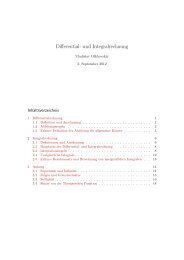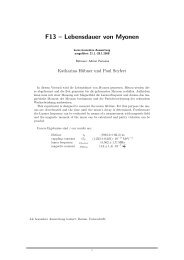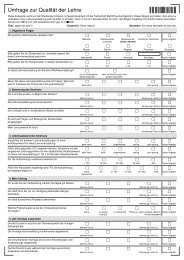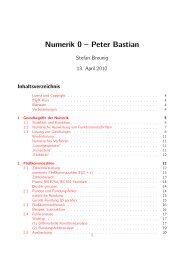Extrasolar Moons as Gravitational Microlenses Christine Liebig
Extrasolar Moons as Gravitational Microlenses Christine Liebig
Extrasolar Moons as Gravitational Microlenses Christine Liebig
You also want an ePaper? Increase the reach of your titles
YUMPU automatically turns print PDFs into web optimized ePapers that Google loves.
CHAPTER 4. CHOICE OF SCENARIOS 37<br />
by previous authors, e.g. Bennett and Rhie (1996). Our standard c<strong>as</strong>e will therefore<br />
have an angular separation of moon and planet of one planetary Einstein ring radius,<br />
dMP = 1.0 θP E . We have to refer back to figure 4.3, to stress again that the shape of<br />
the resulting interference depends on the lunar m<strong>as</strong>s <strong>as</strong> well <strong>as</strong> the separation.<br />
4.1.5 Position angle of moon with respect to planet-star axis<br />
The l<strong>as</strong>t physical parameter necessary for determining the magnification patterns is<br />
the position angle of the moon φ, <strong>as</strong> in figure 4.1. It is the only parameter we do not<br />
fix for our standard scenario. Instead, we vary it in steps of 30 ◦ to complete a full<br />
circular orbit of the moon around the planet. By doing this, we are aiming at getting<br />
complete coverage of a selected m<strong>as</strong>s/separation scenario. Admittedly, it is not to be<br />
expected that we will ever have an exactly head-on view of a perfectly circular orbit,<br />
but it serves well <strong>as</strong> a first approximation and we will not loose much generality with<br />
this <strong>as</strong>sumption. Furthermore, an elliptical orbit would be constructed <strong>as</strong> the sum of<br />
angular separations that vary depending on the position angle. We have simulated<br />
variations in separation, but not yet constructed elliptical orbits.<br />
Caustic interferences of the two caustics of moon and planet can be complex and<br />
we have not yet succeeded in working out a thorough cl<strong>as</strong>sification. We are considering<br />
only orbits of the moon around its host planet which have a circular projection<br />
centred at the planet. These orbits are symmetric along the planet-star axis, and<br />
if we mirror the position of the moon along this axis, the resulting magnification<br />
pattern will also be mirrored. For the axis perpendicular to the aforementioned<br />
one and crossing the centre of the planetary caustic, this kind of symmetry only<br />
holds approximately. As long <strong>as</strong> the planet-star separation is sufficiently large, lunar<br />
magnification lines will have a similar appearance on either side of the planet.<br />
Appendix chapter A contains the analysed magnification patterns and visualises<br />
how the position of the moon affects the planetary caustic.<br />
4.2 Parameters Relevant for Light Curve Analysis<br />
In this section further parameters are discussed: those necessary for determining<br />
the physical properties of the inspected lensing system, and also those required for<br />
simulating realistic light curves. The first three parameters discussed, i.e. distance<br />
to the source star DS, distance to the lensing system DL and the m<strong>as</strong>s of the lensing<br />
star MStar set the “big picture” of Galactic microlensing and serve to convert angular<br />
separations (Einstein radii) to lengths (Astronomical Units). Source size RSource and<br />
sampling rate constrain the shape and sampling density of the simulated light curves.<br />
The observational standard error σ is needed for the final analysis of the light curves.










